All courses taught by students accompanied by practical exercises, design tasks, laboratory work, as well as term papers and projects related to the problems of the integrated use of renewable energy sources. Training and professional practice implemented at leading enterprises and organizations in Moscow and the Moscow Region, as well as in the whole of Russia.
The subject matter of the Bachelor graduation work is related to the solution of problems in assessing the resources of small and traditional hydropower, solar, wind, wave and tidal energy, heat pump installations; on the implementation of water energy and water management calculations; on the selection of basic energy equipment and engineering structures of power plants based on renewable energy sources.
The subject of Master work covers the whole wide range of issues related to the design and operation of power plants based on renewable energy sources, the development of proper mathematical and information support for automated control systems, computer-aided design systems in the field of integrated use of renewable energy sources.
Highly specialized equipment
Hardware and software complex for research of intellectual energy complexes based on renewable energy sources
"Smart Grid" - Power with Brains (ESG 1 Smart Grid, EWG 1 Wind power plants, EPH 2 Advanced photovoltaics, EUG 3 Pumped storage power plant), Lucas-Nülle, Germany, 2013.
Main characteristics
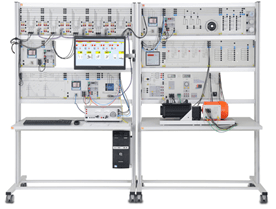
Safety relays - stand-alone protection against current overload with various tripping characteristics
Power switch - automatic and manual on and off voltage (control voltage: 24V; rated operating current: 16A).
Three-phase measuring device with a logger - measurements and an indication of all critical network parameters. SCADA software allows you to display all measured values, as well as create and analyze “Active Adaptive Networks” (Smart Grid).
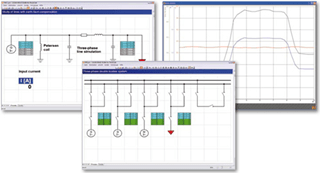
Software - real-time monitoring, control, and data collection of technical processes used to automatically control the processes of energy generation and distribution, planning, and optimization of the operating mode.
High-voltage line model 150 km: phase resistance 3.6 Ohm; phase inductance 115 mg; phase capacitance: line-to-line 2x150 nF, line-to-ground 2x0.55 uF; max. receiving power 1 kW; voltage: 3x400 V, 50/60 Hz; current: 2 A.
Opportunities
The complex equipment allows you to study (independently programming the control center of an intelligent energy system) the algorithms of SmartGrid networks with controlled consumers and generation based on renewable energy sources (electromechanical models of a wind power station and a pumped-storage power plant, a physical model of a solar power plant).
Scientific and technical cooperation
The study of the tasks of managing hybrid energy complexes as part of a wind farm, PSP, SPP, and managed consumers. Modeling of processes of production, transmission, and distribution of energy in smart grids:
- Development of operational switching algorithms on busbars;
- Study of three-phase lines (voltage of a line operating without a load; voltage drop in a line; phase shift in a line; maximum current protection of power lines with time delay);
- Integrated consumers, energy metering and peak load control;
- Manual and automatic reactive power compensation;
- Management of wind power stations;
- Management of photovoltaic network stations;
- Management of synchronous generators of pumped storage power plants.
Laboratory stand of photovoltaic module
EPH 2 Advanced photovoltaics, Lucas-Nülle, Germany, 2013.
Main characteristics
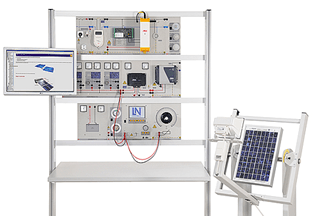
Solar battery simulator (open circuit voltage 23 V; short circuit current 2 A; plug-in bypass diode 40 VA).
Solar battery (open circuit voltage 21 V; short circuit current 650 mA; maximum power: 10 W) with a sun position emulator that allows you to monitor the position of the sun during the year by adjusting the angle of inclination.
Autonomous inverter (power 275 VA; 93% efficiency; protection against overheating and overload, short circuit, and polarity reversal).
Mains inverter (input voltage 45-135 V; output voltage 230 V / 50 Hz; max. Input current: 5A; Efficiency: 95.5%; output power 300 W).
Charge controller (charge and discharge current 10 A; connection of a solar generator, battery, DC load).
Battery 12 V, 7 Ah.
Opportunities
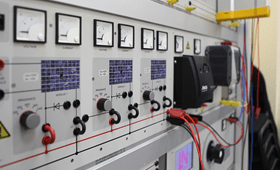
The training system allows you to perform simulated sun trajectories.
Due to this, in the laboratory, it is possible to conduct experiments using emulators, creating natural conditions.
Using the equipment of the stand, you can familiarize yourself with the principles of operation of solar panels, simulate a photovoltaic system when working on an autonomous load and / or an energy storage battery, and simulate the mode of operation of a photoelectric network station.
Scientific and technical cooperation
Research into the design and operation of autonomous and grid solar power plants. Familiarization with the principle of solar cells:
- Studies on the optimal orientation of solar modules;
- Removing the energy characteristics of the solar module;
- Familiarization with serial, parallel and other schemes of connections of solar batteries;
- Study of the principle of operation of shunt diodes;
- An autonomous network device with battery;
- Study of photovoltaic installations operating in parallel with the network;
- Determination of the efficiency of the network inverter.
Laboratory stand of wind turbine
EWG 1 Wind power plants, Lucas-Nülle, Germany, 2013.
Main characteristics
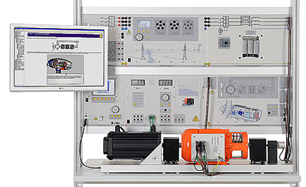
Three-phase multifunctional electric machine (rated voltage 400/230 V, 50 Hz; rated current 2.0 A; rated speed: 1400 rpm; rated power: 0.8 kW; cos φ 0.75).
Dual-supply asynchronous generator controller (control device with two controlled three-phase inverters; operation of the two-way asynchronous generator in super-synchronous and sub-synchronous modes; autonomous adjustment of reactive and useful power, frequency, voltage; automatic synchronization with the network).
The network error simulator contains the following equipment features: adjustable network breakout duration 50 ms to 1000 ms; adjustment of symmetric and asymmetric cases of network errors.
Opportunities
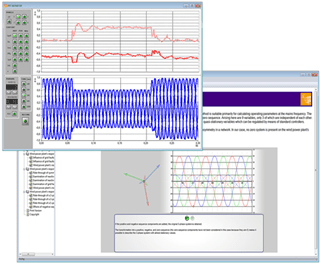
A set of equipment provides the study of modern wind power installations with dual power generators.
Torque on a wind turbine emulated close to actual conditions using a direct-current machine and WindSim software.
Communication with a personal computer provides easy maintenance and visualization during experiments.
The ability to emulate in the laboratory the same conditions as in real wind power plants:
- Reliable emulation of wind and blade geometry;
- Automatic regulation of the number of revolutions and torque depending on the wind speed and the angle of rotation of the blade of the wind wheel;
- Change in wind speed over time;
- Registration of mechanical and electrical parameters.
Scientific and technical cooperation
Research on the design and operation of wind farms. Familiarization with the principle of operation of wind power plants with dual power generators:
- Study of the design and principle of operation of wind power plants;
- Study of the physical foundations of energy conversion "from wind to shaft";
- Study of the design and operation principle of an asynchronized synchronous generator;
- Regulation of the output voltage and frequency of the generator depending on the wind speed;
- Determination of optimal operating points in a changing wind;
- Investigation of the behavior of the wind power installation in emergencies (short circuits) in the network.
Laboratory stand of pumped storage power plant
EUG 3 Pumped storage power plant, Lucas-Nülle, Germany, 2013.
Main characteristics

The multifunctional relay is suitable for controlling, protecting, and monitoring generators. Management Functions:
- Auto-sync automatic power adjustment;
- Automatic distribution of active and reactive power (protection functions).
The control unit of the accumulating power station allows you to manage and monitor the training system "Pump storage power plant" using the SCADA program.
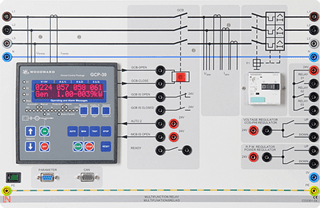
Three-phase synchronous machine with a cylindrical rotor (rated voltage 400 / 230V, 50Hz; rated current 1.5A; nominal speed of 1500 rpm; rated power 0,8 kW; cos φ 0.8-1.0).
The synchronization unit has the following composition: synchronization display (3 lamps) to indicate voltage and phase shift; zero voltage meter; dual frequency meter; dual voltmeter; digital synchronoscope.
Opportunities
At pumped storage power plants, electricity is accumulated by converting water into potential energy and, after converting this potential energy into electric energy, is returned to the grid. Due to the growing share of electricity produced from renewable sources, they are necessary and indispensable energy storage devices in high-quality intelligent networks.
Scientific and technical cooperation
The study of the tasks of the operation of pumped storage power plants. Familiarization with the principle of operation of pumped storage power plants:
- Start and synchronization of a synchronous electric machine;
- Manual power control: in generator and motor mode;
- Semi-automatic regulation of active and reactive power;
- Modes of pumped storage power plants in smart grids;
- Automatic compensation of vibrations of active and reactive power
Laboratory complex "Renewable energy sources"
NEE1-MFESE-S-R "Model of a photovoltaic solar power plant", NEE2-VEG-NR "Model of a wind turbine", Scientific and Educational Center "Educational Equipment", Russia, 2010.
Main characteristics

The composition of the laboratory stand "Full-scale model of a wind generator":
- full-scale analogue of the wind generator (10 V, 0.1 A, impeller diameter 0.22 or 0.31 m);
- measuring transducers and devices;
- outdoor fan.
Power consumption - no more than 60 VA.
The composition of the laboratory stand "Model of a photovoltaic solar power plant":
- photovoltaic module unit (20 V, 0.35 A, 4.8 W);
- measuring transducers and devices;
- charge-discharge controller (75 V, 1 A, efficiency 97.5%, protection against overload and reverse polarity);
- capacitive storage (28 F, 12 V).
Power consumption - no more than 7000 VA.
Opportunities
The functionality of the complex allows you to get acquainted with the energy characteristics of solar and wind power plants, the influence of external factors on them, the operating modes of solar and wind power plants operating in power systems of various capacities (from stand-alone consumers to work in a single power system) and their management features.
An opportunity to study: volt-ampere and energy characteristics of the photovoltaic module; the dependence of the energy characteristics of the solar module on illumination and the angle of incidence of light rays on its surface; temperature dependences of the solar module; to carry out modeling of the operating modes of an autonomous photoelectric solar system; wind turbine performance; dependences of the wind energy coefficient of use of a wind turbine in various working conditions.
Scientific and technical cooperation
Study of the main energy characteristics of solar and wind power plants:
- determination of the dependences of the power of a synchronous generator and the moment of a wind turbine on the rotation frequency at a constant wind speed;
- removing the dependence of the frequency of rotation of the wind turbine on the wind speed, with constant load resistance;
- determination of the dependence of the power of the synchronous generator on the wind speed at a constant rotational speed of the wind turbine;
- determination of the dependence of the speed of the wind turbine on the wind speed at the maximum value of the power of the synchronous generator;
- removal of the volt-ampere and energy characteristics of the photovoltaic module at various illumination values;
- taking characteristics of the photovoltaic module from the angle of incidence of light rays on its surface;
- removing the dependence of the maximum power of the photovoltaic module on its temperature.
Hardware and software complex for research of intellectual energy complexes on the basis of renewable energy sources
NEE1-VEU-S-K "Electromechanical model of a wind turbine", Scientific and Educational Center "Educational Equipment", Russia, 2010.
Main characteristics
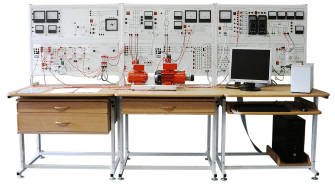
Electric machine unit:
- DC machine (90 W, 220 V, 0.56 A, 1500 rpm);
- AC machine (100 W, 220 V, cos φ 1.0, 1.4 A, 1500 rpm).
Thyristor converter (450 V, 40 A, overcurrent protection, control voltage 10 V).
Autonomous inverter (10 ... 15 V, 10 A, 50 Hz, efficiency 90%, the output is a modified sine wave).
Active load (3 phases, 50 W, 220 V, 0.25 A).
Charge / discharge controller (75 V, 1 A, 97.5% efficiency, overload and reverse polarity protection)
Capacitive storage (600 F, 12 V).
Opportunities
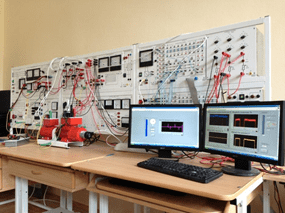
Laboratory stands for wind energy allow you to study:
- the performance of a wind turbine;
- the dependence of the wind energy coefficient of the wind turbine in various operating conditions;
- operating modes of wind turbines, including an asynchronous, synchronous generator or a synchronous generator directly connected to the network through a direct current insert and an inverter; to simulate the operating modes of a wind power plant operating on an autonomous consumer.
Scientific and technical cooperation
Familiarization with the principle of wind-driven installations operating in stand-alone mode and parallel with the network:
- removal of operational characteristics of a wind turbine operating at an isolated load;
- removal of operational characteristics of a wind turbine, including a synchronous or asynchronous generator directly connected to the network;
- removal of operational characteristics of a wind turbine, including a synchronous generator connected to the network through a direct current insert and an inverter;
- removal of operational characteristics of an autonomous inverter of a wind power installation;
- modeling of operating modes of an autonomous wind power installation.